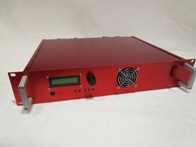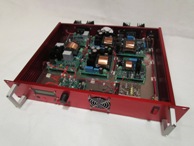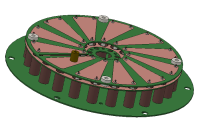Projects
A summary of our projects.
A summary of our projects.
 For the FAST sintering technique a high current is past directly through the sintering material. The material
normally consists of nano-powders of different materials (e.g. carbon, titanium, etc.). This sintering technique
is much faster than other conventional sintering methods, where the sintering material is placed in an oven.
The challenge is to provide sufficient current to heat the low-resistance sintering load. For this purpose a
novel high-current power supply was developed. The power supply can be operated in continuous or pulsed mode. In pulsed mode
very large output currents can be generated, making it ideal for the FAST sintering process.
For the FAST sintering technique a high current is past directly through the sintering material. The material
normally consists of nano-powders of different materials (e.g. carbon, titanium, etc.). This sintering technique
is much faster than other conventional sintering methods, where the sintering material is placed in an oven.
The challenge is to provide sufficient current to heat the low-resistance sintering load. For this purpose a
novel high-current power supply was developed. The power supply can be operated in continuous or pulsed mode. In pulsed mode
very large output currents can be generated, making it ideal for the FAST sintering process.
Presently, a second generation power supply is being developed to increase the continuous output current to 500 A. Up to ten of these power supplies can be connected in parallel to obtain a continuous sintering current of 5 kA and a pulsed current of 10 kA.
 This power supply was originally developed for the University of
Stellenbosch (Stellenbosch, South Africa), department of Electronic Engineering. It replaced the previous
DC sputtering power supply and dramatically increased the reliability and repeatability of thin-film production
at the university. The 3rd generation of this power supply was recently delivered to the
King Abdullah University of Science and Technology (KAUST) (Thuwal, Saudi Arabia).
This power supply was originally developed for the University of
Stellenbosch (Stellenbosch, South Africa), department of Electronic Engineering. It replaced the previous
DC sputtering power supply and dramatically increased the reliability and repeatability of thin-film production
at the university. The 3rd generation of this power supply was recently delivered to the
King Abdullah University of Science and Technology (KAUST) (Thuwal, Saudi Arabia).
Sputtering is a technique to manufacture thin films (nano-scale). One example is the manufacturing of super-conducting
thin films for SQUIDs. In order to achieve sputtering of the target material an Argon plasma is generated. Older techniques
used DC voltages between 200 V and 600 V. A more modern approach is to used pulsed DC. In this case the energy density
of the plasma is much higher and faster deposition rates can be achieved. It was also found that pulsed DC generates a
more stable plasma and greatly increases the sputtering quality and repeatability. In addition pulsed DC makes sputtering of
non-conducting materials (e.g. silicon-dioxide) possible. Pulsed DC sputtering requires a large negative voltage (300-800 V)
and a smaller positive reset voltage (0-50 V). Adjustable pulse frequency (10-350 kHz) and duty cycle (5-95 %) are required.
 The power supply was designed and constructed using a modular approach and contains both PFC and DC-DC isolation.
An innovative hybrid analogue/digital control was used to obtain stable constant power, current or voltage output.
The output capacitance of the power supply is very low. This prevents destructive arcing, which can damage the
sputtering sample.
The power supply was designed and constructed using a modular approach and contains both PFC and DC-DC isolation.
An innovative hybrid analogue/digital control was used to obtain stable constant power, current or voltage output.
The output capacitance of the power supply is very low. This prevents destructive arcing, which can damage the
sputtering sample.
 This project was completed in co-operation with Laser Systems & Applications (Pty) Ltd for PaR Systems.
The pulser was developed to replace the previous pulser for their WH family of CO2 TEA lasers. The new pulser is based on modern high-voltage
IGBT switches with excellent reliability and long life-time.
Pulsers for CO2 TEA lasers are required to generate very fast (< 200 ns), high-voltage (> 30k V) pulses. This is necessary to
ensure stable gas discharges at atmospheric pressures.
Solid-state switches (e.g. IGBTs) have limited switching voltage and switching speed ratings. In order to generate higher voltage pulses with faster rise-times,
pulse transformers and magnetic pulse compression (MPC) techniques are required.
This project was completed in co-operation with Laser Systems & Applications (Pty) Ltd for PaR Systems.
The pulser was developed to replace the previous pulser for their WH family of CO2 TEA lasers. The new pulser is based on modern high-voltage
IGBT switches with excellent reliability and long life-time.
Pulsers for CO2 TEA lasers are required to generate very fast (< 200 ns), high-voltage (> 30k V) pulses. This is necessary to
ensure stable gas discharges at atmospheric pressures.
Solid-state switches (e.g. IGBTs) have limited switching voltage and switching speed ratings. In order to generate higher voltage pulses with faster rise-times,
pulse transformers and magnetic pulse compression (MPC) techniques are required.
Synertronic Designs acted as a consultant on this project and was responsible for:
Synertronic Designs played a key role in the design of the fast pulse transformer for this project. The final design was very compact and reliable. The transformer and new pulser design was subsequently patented by PaR Systems.
 In order to support multi-axis translation and rotation stages for CNC applications, the Uragan-SO project was launched.
It entails the development of a multi-axis controller with an USB interface.
At this stage up to 5 Uragan-µ devices can be connected. Support for a generic stepper motor interface
(direction & step) is being investigated. This will enable Uragan-SO to control other types of stepper motor drivers
including low-cost, low-power stepper motor drivers currently available on the market.
In order to support multi-axis translation and rotation stages for CNC applications, the Uragan-SO project was launched.
It entails the development of a multi-axis controller with an USB interface.
At this stage up to 5 Uragan-µ devices can be connected. Support for a generic stepper motor interface
(direction & step) is being investigated. This will enable Uragan-SO to control other types of stepper motor drivers
including low-cost, low-power stepper motor drivers currently available on the market.
For convenience and ease-of-use, Uragan Studio will be used as the graphical user interface to configure and generate the command stream for Uragan-SO.
 Glaz-I is a high-end data acquisition system for spectroscopic applications. It features a powerful processing unit to which up
to four sensor modules can be connected. At least 10,000 measurements from 4 sensors can be processed per second. Measurements
are averaged to obtain extermely low noise levels. The averaged, post-processed data is uploaded to a PC via USB.
Glaz-I is a high-end data acquisition system for spectroscopic applications. It features a powerful processing unit to which up
to four sensor modules can be connected. At least 10,000 measurements from 4 sensors can be processed per second. Measurements
are averaged to obtain extermely low noise levels. The averaged, post-processed data is uploaded to a PC via USB.
Sensor modules can be installed remotely and are connected to the processing unit via high-speed serial interfaces. The sensor modules include an optical
linear sensor array and high-performance ADC converters to achieve the highest possible signal to noise ratio.
The system architecture allows different linear sensor array types to be connected to the processing unit. These can range from CMOS to CCD sensor arrays. Basic post-processing of the measured optical data is performed by the sensor modules.
Several post-processing algorithms are supported and include:
 In conjuntion with MotionSynth (New Zealand) a new wireless marker system, Firefly, for motion capturing was developed.
Each system conists of a sync unit with a highly accurate clock and up to 50 IR wireless markers. An RF link
between the IR markers and sync unit ensures that the IR markers stay synchronised with the motion capture
cameras. The sync unit needs to be synchronised with the motion capture master/reference clock. After synchronisation, the sync unit
will stay synchronised with the camera reference clock for more than 10 hours.
In conjuntion with MotionSynth (New Zealand) a new wireless marker system, Firefly, for motion capturing was developed.
Each system conists of a sync unit with a highly accurate clock and up to 50 IR wireless markers. An RF link
between the IR markers and sync unit ensures that the IR markers stay synchronised with the motion capture
cameras. The sync unit needs to be synchronised with the motion capture master/reference clock. After synchronisation, the sync unit
will stay synchronised with the camera reference clock for more than 10 hours.